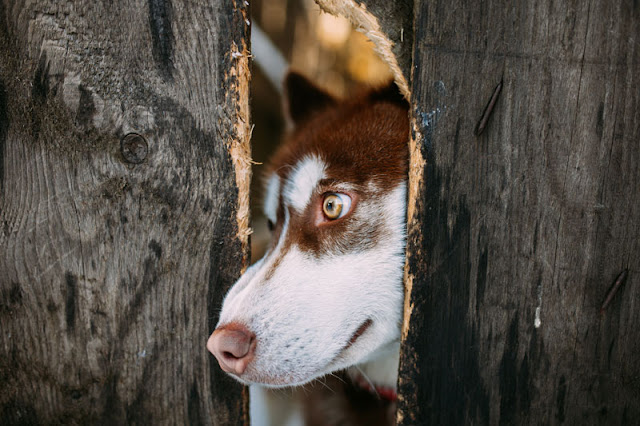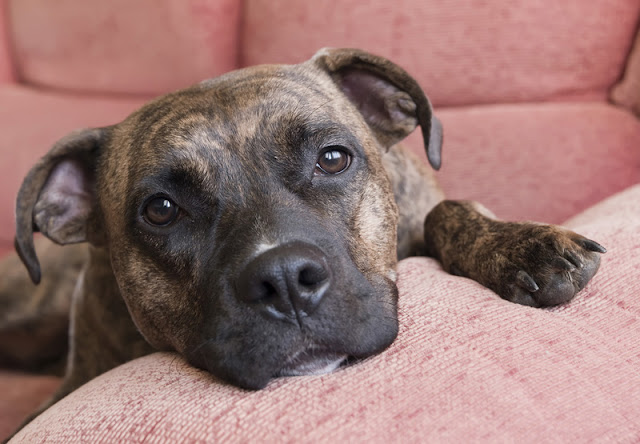How to Help Your Dog with Fireworks Fears
If your dog is terrified of fireworks, here are the things you can do to help, both in the short- and long-term.
 |
| Photo: Anna Hoychuk/Shutterstock |
It’s a problem for many at this time of year. One loud bang and your dog is quaking and shaking. It’s awful to see your best friend so terrified, but luckily there are things that you can do to help.
This post contains affiliate links which means I may earn a commission on qualifying purchases at no cost to you.
Fear of fireworks is common in dogs
If your dog is afraid of fireworks, you’re not alone. Somewhere between a fifth and half of all dogs are scared of fireworks, depending which survey you look at (Kurachi and Irimajiri 2019; Riemer 2019; Salonen et al 2020). One study found that the numbers increased significantly when people were asked more direct questions such as whether the dog trembles when there are fireworks, rather than just if their dog was scared of them (Blackwell et al 2013).
Common signs in dogs who are afraid of fireworks including seeking out the guardian, trembling, shaking, panting, pacing, hiding, vocalizing, and the ears going back (Mann et al 2024; Gähwiler et al 2020).
If you recognize that your dog is scared of fireworks, that gives you the opportunity to do something about it. Unfortunately, doing nothing is not likely to help (Riemer, 2019), so read on to learn about what you can do.
Safety first with fireworks
If it’s a time when you know that fireworks are expected, make sure that you take your dog out early in the day and keep them on leash. They need to be able to toilet before all the scary noises start to happen. Keep them on leash to avoid the risk of them getting frightened and running away. For the same reason, make sure they are inside your house before any fireworks start.
Speak to your veterinarian about fear of fireworks
If your dog is afraid of fireworks, it’s worth speaking to your veterinarian. They might recommend some short-acting medications to help your dog get through the night(s) when there are lots of bangs and whistles. Ideally, do this a bit ahead of time because they might suggest that you do a trial run to check that the dosage is right. That would give time for them to make any adjustments if they are needed.
Another time when you should speak to your vet about your dog’s fear of fireworks is if this is a new fear. Sometimes a dog is perfectly okay with fireworks when they are young, but as they get older a fear develops. If you see your vet, they will be able to assess whether or not a medical issue such as pain is contributing to the fear (Mills et al).
Set the room up
Have a safe space for your dog to be when there are fireworks going off. If your dog likes to use a crate as a safe space, make sure it is covered by a sheet or blanket, and keep the door open so that your dog is free to come and go.
Close blinds and drapes to try to keep the flashes out of the room.
You can also use noise to help to drown out the sounds of the fireworks. Many people like to play music or have the TV on, but it might not be the best thing. Fireworks make a lot of rumbly sounds, so you need something to drown out that rumble. Consider having the dishwasher or washing machine on, putting some trainers (sneakers) in the tumble drier, or look for a recording of brown noise to play (Anderson, 2024).
But don’t expect this to be enough. You should still plan to do some training with your dog to help them get used to the sound of fireworks.
Choose AMAZING treats
You’re going to need to choose amazing treats to use in training. Kibble won’t do, because you need something that will create a wonderful surprise for your dog.
Think about what your dog really loves. Maybe it’s pieces of roast chicken, cheese, or roast beef. Plan in advance to have some of those treats available on bonfire night, Halloween, New Year’s Eve, Canada Day, or 4th July.
On the day itself, you can only do what we call ad-hoc counterconditioning. What this means is that when you hear a firework, you run to the fridge or treat jar to get some of those amazing treats, and offer them to your dog.
If this is the first time you have started this training, your dog is probably going to be too scared to eat the treats. But offer them anyway, and make sure that they get the chance to eat them once the noises have stopped and they have finally been able to calm down.
But it’s best to plan to do some training in the months leading up to the fireworks.
Training your dog to help with fear of fireworks
There are two techniques that we combine to teach dogs to learn that fireworks are okay, in fact better than that, because they predict amazing treats. We use desensitization and counterconditioning.
I’ve got definitions and details of these in my book Bark! The Science of Helping Your Anxious, Fearful, or Reactive Dog. Here’s what these terms mean:
“Desensitization is the process of very gradually getting the dog used to something.” (Bark!, p91).
And:
“The aim of counterconditioning is to teach the dog to love the thing they were previously scared of.” (Bark!, p81).
To do this training, find a recording of fireworks sounds. Wear headphones when you check it for yourself—you don’t want to accidentally scare your dog.
Turn the volume right down, so low that it is barely perceptible. Start to play the recording, then get some of those amazing treats you prepared in advance and give them to your dog. Then stop the recording and stop the treats.
That’s it. If you make time to do this a few times a week, over time it will start to make a difference. With time, as you see that your dog is really happy during the training, you’ll be able to gradually turn up the volume of the recording. And eventually your dog will learn to be happy about the sound of fireworks because they will learn that every time they hear the sound, they will get these amazing treats.
Train at random times of the day. If you were to always train at 6pm, for example, dogs have a good sense of time and so they would learn that 6pm means treats. You want to make sure they learn that the sound of fireworks predicts treats.
Bangs in daily life
Many dogs who are afraid of fireworks are also afraid of loud noises in everyday life. You can take advantage of these as a training opportunity and use them to start to teach your dog that these bangs are okay too.
To do so, you’ll need to plan in advance. If you’re at home when a loud bang occurs, you can run to the fridge or your treat jar to get a treat for your dog.
But sometimes loud bangs will happen on a walk, like when a car backfires. So think about what would be a treat that your dog absolutely loves that you can take on all walks with you, in a bait bag or in a little baggie in your pocket.
This should be something you can take every time, but which is not necessarily going to get used (only if there’s a bang!). So it should be something that doesn’t need to be refrigerated. Maybe some kind of tripe treat or sausage treat would work for your dog?
Then, whenever a bang occurs, give the treat to your dog. If you want to know more about how to make this work, you can read a story in Bark! of me using this method with my late dog Bodger.
Some common mistakes
There are some common mistakes that people make when trying to use desensitization with their dog, and unfortunately they can mean that it doesn’t work.
Always make sure your dog hears the noise first, before you even reach for a treat. Often, we know that a bang or other loud noise is coming, and so sometimes we reach for the treat before the bang has happened. Dogs are very good observers, and what they might learn from this is that you getting a treat predicts a bang. That’s the wrong way round! So always wait for the noise to happen first.
This might mean you have to prepare the treats well in advance of your training session.
It’s also easy to accidentally get desensitization wrong by playing the sounds too loud. If you accidentally startle your dog, immediately stop the sounds—and make sure you still offer the treats.
Then turn the volume way down before you try another training session.
Preventing fear of loud noises
When you have a puppy, you have an opportunity to prevent fear of fireworks from developing in the first place. That’s because puppies have a sensitive period from 3 until about 12-14 weeks when a wide range of positive experiences will help them to grow up and become a friendly, confident adult dog.
To do this, you can use the desensitization and counterconditioning technique. Pay really close attention to your puppy’s body language, because the last thing you want to do is scare your puppy—that could have long-lasting consequences. So start the training very, very carefully to ensure that your puppy only has a positive experience.
Some puppy classes will include some desensitization to fireworks and other noises. A good puppy class is a great way to get some socialization in for your puppy. Make sure you only pick a trainer who will use reward-based methods!
 |
| Get Bark! |
Good luck with your dog and the fireworks. Let me know how it goes.
If you need more tips, check out my book Bark! The Science of Helping Your Anxious, Fearful, or Reactive Dog. The Guardian calls it “Encyclopedic in scope and packed with references to new findings in animal behaviour.”
References
Anderson, E. (2024). " Acoustic Masking" for Sound-Sensitive Dogs: Masking is the most effective way to protect dogs from unwanted noises such as thunder, fireworks, or electronic beeps. Whole Dog Journal, 27(2), 20-23.
Blackwell, E. J., Bradshaw, J. W., & Casey, R. A. (2013). Fear responses to noises in domestic dogs: Prevalence, risk factors and co-occurrence with other fear related behaviour. Applied Animal Behaviour Science, 145(1-2), 15-25.
Lopes Fagundes, A. L., Hewison, L., McPeake, K. J., Zulch, H., & Mills, D. S. (2018). Noise sensitivities in dogs: an exploration of signs in dogs with and without musculoskeletal pain using qualitative content analysis. Frontiers in veterinary science, 5, 17.
Gähwiler, S., Bremhorst, A., Tóth, K., & Riemer, S. (2020). Fear expressions of dogs during New Year fireworks: a video analysis. Scientific reports, 10(1), 16035.
Mann, A. S., Hall, E., McGowan, C., & Quain, A. (2024). A survey investigating owner perceptions and management of firework‐associated fear in dogs in the Greater Sydney area. Australian veterinary journal, 102(10), 491-502.
Riemer S (2019) Not a one-way road—Severity, progression and prevention of firework fears in dogs. PLoS ONE 14(9): e0218150.
Riemer, S. (2020). Effectiveness of treatments for firework fears in dogs. Journal of Veterinary Behavior.




